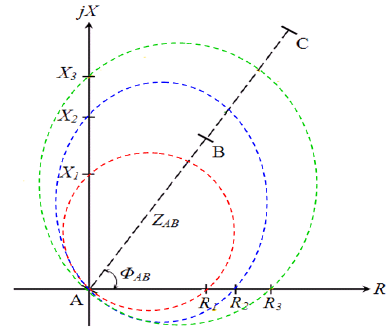
Structure and working principle of Mho relay
A simple form of Mho relay Admittance or angular admittance relays as shown in the following figure:

It is a kind of cup with electromagnetic induction MHO relay .
The torque equation is T = K 1 VI (Φ – α) – K 2 v 2 –K 3
The upper and lower poles are excited by a voltage V to produce a polarizing flux. The capacitor connected in series provides a storage function. The left pole is excited by a current, which is the operational quantity. The left pole interacts with the due to current I polarized flow due to V produces the Operating torque K 1 VI Cos (Φ – α)
The angle α can be adjusted by adjusting the resistance in Phase shift circuit provided on the left pole. The right pole is excited by the voltage and the flux it produces interacts with the polarizing flux to produce the Holding Torque K 2 v 2 .


The mho Relay measures a component of Allow S ∠θ. But its characteristics when you look at it on the Impedance Diagram (i.e. RX Chart ) is a circle that passes through the origin shown in the figure. It is a directional relay in nature as it detects the fault only in the forward direction. The relay is called Mho relay because its characteristic is a straight line when in Intake diagram (GB axes i.e. conductance-susceptance axes) as in the figure.
- Read: Directional Overcurrent Relay
- Read: Solid State Relay or Static Relay
Characteristic expression of the Mho relay
The operating torque for an Mho relay occurs through the VI element and the restraining torque occurs through the voltage element.
Therefore mho relay can as voltage dependent directional relay .
T = K 1 VI Cos (Φ – α) –K 2 v 2 where the effect of the spring is neglected.
K 2 v 2 < K 1 VI Cos (Φ – α)
K2V 1I cos (Φ – α)
(V/I cos (Φ – α)) < K 1 /K 2 or (V/I) < (K 1 /K 2 ) Cos (Φ – α) or Z < (K 1 /K 2 )Cos (Φ – α)
Under equilibrium conditions, the operating torque is equal to the holding torque.
that is, K 1 VICos (Φ – α) = K 2 v 2
(I/V)Cos (Φ – α) = (K 2 K 1 ) =K
(1/Z) = (K / Cos (Φ – α)) = Y
Y = K / Cos (Φ – α) = admittance in mho.
These MHO relay units are used to protect a section of line. Unit I is a high speed unit designed to protect 80% to 90% of the line section. Unit II protects the remainder of the line section and its range extends up to 50% of the adjacent line section. Unit III is intended for backup protection of the adjacent line section. Units II and III operate with a predefined time delay, typically 0.2s to 0.5s and 0.4s to 1s, respectively. The time delay characteristic is gradual, as shown in the figure.

Operation of impedance and Mho relays during power swing
Comparison of Mho characteristic and impedance characteristic under voltage fluctuations AB is the line to be protected. The relay with impedance characteristic trips even at fault points behind position A, which is nothing more than a “fault trip”.
On the other hand, the relay with Mho characteristic, which requires a comparatively small circular area for line AB, does not detect the errors behind A. Therefore, many points covered by the impedance characteristic are in the negative torque range of the Mho characteristic.
The location of power fluctuation that occurs in long transmission lines during false synchronization, etc. is a transient phenomenon and a curve that enters the operating range of an impedance relay before the Mho relay. This is undesirable because the transmission line itself will be turned off by the impedance relay protection before the power fluctuation can subside. However, with the strong and rapid occurrence of a power fluctuation, the location may enter the operating range of the Mho relay, which intervenes and disconnects the line, which is also undesirable. Therefore, to avoid this kind of situation, mho offset relay is used as shown below.

During power swing, the location of the impedance measured by the relay moves along the curve. As soon as it enters the positive torque range of the Mho offset characteristic (point P), the Mho offset relay is activated and blocks the BC line measuring relay. Therefore, Mho relay does not operate during power swing.
Comparison Table
| S. No | Relay type | Actuating Torque Element | Torque Retaining Element | Used for protection |
| 1 | Impedance relay (Z) | Current (me) | Voltage (V) | Phase errors in medium length cables |
| two | Reactance relay (X) | Current (I2) | Voltage – Current SinΦ (V – I sin Φ) | Earth faults in short cables |
| 3 | Approval relay (Y) | VI Cos (Φ – α) | v | Phase errors in long cables |

